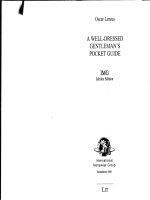java pocket guide
Bạn đang xem bản rút gọn của tài liệu. Xem và tải ngay bản đầy đủ của tài liệu tại đây (2.21 MB, 193 trang )
www.it-ebooks.info
www.it-ebooks.info
Java
™
Pocket Guide
www.it-ebooks.info
www.it-ebooks.info
Java
™
Pocket Guide
Robert Liguori and Patricia Liguori
Beijing
•
Cambridge
•
Farnham
•
Köln
•
Paris
•
Sebastopol
•
Taipei
•
Tokyo
www.it-ebooks.info
Java
™
Pocket Guide
by Robert Liguori and Patricia Liguori
Copyright © 2008 Robert Liguori and Patricia Liguori. All rights reserved.
Printed in Canada.
Published by O’Reilly Media, Inc., 1005 Gravenstein Highway North,
Sebastopol, CA 95472.
O’Reilly books may be purchased for educational, business, or sales
promotional use. Online editions are also available for most titles
(safari.oreilly.com). For more information, contact our corporate/
institutional sales department: (800) 998-9938 or
Editor:
Mike Loukides
Production Editor:
Rachel Monaghan
Copyeditor:
Loranah Dimant
Proofreader:
Rachel Monaghan
Indexer:
Julie Hawks
Cover Designer:
Karen Montgomery
Interior Designer:
David Futato
Illustrator:
Robert Romano
Printing History:
March 2008: First Edition.
Nutshell Handbook, the Nutshell Handbook logo, and the O’Reilly logo are
registered trademarks of O’Reilly Media, Inc. The Pocket Guide series
designations, Java Pocket Guide, the image of a Javan tiger, and related trade
dress are trademarks of O’Reilly Media, Inc.
Java™ and all Java-based trademarks and logos are trademarks or registered
trademarks of SunMicrosystems, Inc., in the United States and other countries.
Many of the designations used by manufacturers and sellers to distinguish
their products are claimed as trademarks. Where those designations appear
in this book, and O’Reilly Media, Inc. was aware of a trademark claim, the
designations have been printed in caps or initial caps.
While every precaution has been taken in the preparation of this book, the
publisher and authors assume no responsibility for errors or omissions, or
for damages resulting from the use of the information contained herein.
ISBN: 978-0-596-51419-8
[TM]
www.it-ebooks.info
v
Contents
Preface xi
Part I. Language
Chapter 1:
Naming Conventions 3
Class Names 3
Interface Names 3
Method Names 3
Instance and Static Variable Names 4
Parameter and Local Variables Names 4
Generic Type Parameter Names 4
Constant Names 5
Enumeration Names 5
Package Names 5
Acronyms 5
Chapter 2:
Lexical Elements 6
Unicode and ASCII 6
Comments 8
Keywords 9
Identifiers 10
www.it-ebooks.info
vi
|
Contents
Separators 10
Operators 10
Literals 12
Escape Sequences 15
Unicode Currency Symbols 15
Chapter 3:
Fundamental Types 17
Primitive Types 17
Literals for Primitive Types 18
Floating-Point Entities 20
Numeric Promotion of Primitive Types 21
Wrapper Classes 23
Autoboxing and Unboxing 24
Chapter 4:
Reference Types 26
Comparing Reference Types to Primitive Types 26
Default Values 27
Conversion of Reference Types 28
Converting Between Primitives and Reference Types 29
Passing Reference Types into Methods 30
Comparing Reference Types 31
Copying Reference Types 33
Memory Allocation and Garbage Collection of
Reference Types 35
Chapter 5:
Object-Oriented Programming 36
Classes and Objects 36
Variable Length Argument Lists 42
Abstract Classes and Abstract Methods 43
www.it-ebooks.info
Contents
|
vii
Static Data Members, Static Methods, and Static Constants 44
Interfaces 46
Enumerations 46
Annotations Types 47
Chapter 6:
Statements and Blocks 50
Expression Statements 50
Empty Statement 51
Blocks 51
Conditional Statements 51
Iteration Statements 53
Transfer of Control 54
Synchronized Statement 56
Assert Statement 56
Exception Handling Statements 57
Chapter 7:
Exception Handling 58
The Exception Hierarchy 58
Checked/Unchecked Exceptions and Errors 59
Common Checked/Unchecked Exceptions and Errors 60
Exception Handling Keywords 62
The Exception Handling Process 65
Defining Your Own Exception Class 66
Printing Information About Exceptions 66
Chapter 8:
Java Modifiers 69
Access Modifiers 70
Other (Non-Access) Modifiers 71
www.it-ebooks.info
viii
|
Contents
Part II. Platform
Chapter 9:
Java Platform, SE 75
Common Java SE API Libraries 75
Chapter 10:
Development Basics 87
Java Runtime Environment 87
Java Development Kit 87
Java Program Structure 88
Command-Line Tools 90
Classpath 96
Chapter 11:
Basic Input and Output 97
Standard Streams in, out, and err 97
Class Hierarchy for Basic Input and Output 98
File Reading and Writing 99
Socket Reading and Writing 101
Serialization 103
Zipping and Unzipping Files 104
File and Directory Handling 105
Chapter 12:
Java Collections Framework 107
The Collection Interface 107
Implementations 107
Collection Framework Methods 109
Collections Class Algorithms 109
Algorithm Efficiencies 110
Comparator Interface 112
www.it-ebooks.info
Contents
|
ix
Chapter 13:
Generics Framework 114
Generic Classes and Interfaces 114
Constructors with Generics 115
Substitution Principle 115
Type Parameters, Wildcards, and Bounds 116
The Get and Put Principle 117
Generic Specialization 118
Generic Methods in Raw Types 119
Chapter 14:
Concurrency 120
Creating Threads 120
Thread States 121
Thread Priorities 122
Common Methods 122
Synchronization 123
Concurrent Utilities 125
Chapter 15:
Memory Management 129
Garbage Collectors 129
Memory Management Tools 131
Command-Line Options 132
Resizing the JVM Heap 134
Interfacing with the GC 134
Chapter 16:
The Java Scripting API 136
Scripting Languages 136
Script Engine Implementations 136
Setting Up Scripting Languages and Engines 138
www.it-ebooks.info
x
|
Contents
Chapter 17:
Third-Party Tools 142
Development Tools 142
Libraries 144
IDEs 144
Web Application Platforms 145
Scripting Languages 147
Chapter 18:
UML Basics 149
Class Diagrams 149
Object Diagrams 151
Graphical Icon Representation 152
Connectors 153
Multiplicity Indicators 153
Role Names 154
Class Relationships 154
Sequence Diagrams 156
Index 159
www.it-ebooks.info
xi
Chapter 1
Preface
Designed to be your companion in the office, in the lab, or
even on the road, this pocket guide provides a quick refer-
ence to the standard features of the Java™ programming lan-
guage and its platform.
This pocket guide provides you with the information you will
need while developing or debugging your Java programs,
including helpful programming examples, tables, figures, and
lists.
It also contains supplemental information about things such
as the new Java Scripting API, third-party tools, and the
basics of the Unified Modeling Language (UML).
Coverage is provided through the Java 6 Platform.
Book Structure
This book is broken into two sections: language and plat-
form. Chapters 1 through 8 detail the Java programming lan-
guage as derived from the Java Language Specification (JLS).
Chapters 9 though 18 detail Java platform components and
related topics.
www.it-ebooks.info
xii
|
Preface
Font Conventions
Italic
Denotes filenames, file extensions (such as .java), and
directory paths.
Constant width
Denotes class names, types, methods, data members,
commands, properties, and values.
Constant width italic
Indicates user-supplied values.
Comments and Questions
Please address comments and questions concerning this
book to the publisher:
O’Reilly Media, Inc.
1005 Gravenstein Highway North
Sebastopol, CA 95472
800-998-9938 (in the United States or Canada)
707-829-0515 (international or local)
707-829-0104 (Fax)
There is a web page for this book, which lists errata, examples,
or any additional information. You can access this page at:
/>To comment or ask technical questions about this book,
send email to:
For information about books, conferences, Resource Cen-
ters, and the O’Reilly Network, see the O’Reilly web site at:
www.it-ebooks.info
Preface
|
xiii
Authors
Robert Liguori is a Senior Software Engineer for Management,
Engineering and Technology Associates, Inc. Patricia Liguori is
a Lead Information Systems Engineer for The MITRE Corpora-
tion. The authors may be contacted in regards to comments,
questions, or errata found in this book at
Safari® Books Online
When you see a Safari® Books Online
icon on the cover of your favorite technol-
ogy book, that means the book is avail-
able online through the O’Reilly Network
Safari Bookshelf.
Safari offers a solution that’s better than e-books. It’s a vir-
tual library that lets you easily search thousands of top tech
books, cut and paste code samples, download chapters, and
find quick answers when you need the most accurate, cur-
rent information. Try it for free at .
Acknowledgments
We extend a special thank you to our editor, Mike Loukides.
His Java prowess, responsiveness, and ongoing collaboration
have made writing this book an enjoyable experience.
Appreciation goes out to our technical reviewers and sup-
porters: Mary-Ann Boyce, Kelly Connolly, Edward Finegan,
David Flanagan, David King, Chris Magrin, Confesor Santi-
ago, Wayne Smith, Martin Suech, and our families.
Dedication
This book is dedicated to our daughter, Ashleigh.
www.it-ebooks.info
www.it-ebooks.info
PART I
I. Language
www.it-ebooks.info
www.it-ebooks.info
3
CHAPTER 1CHAPTER 1
Naming Conventions
Naming conventions are used to make Java programs more
readable. It is important to use meaningful and unambiguous
names comprised of ASCII letters.
Class Names
Class names should be nouns, as they represent “things” or
“objects.” They should be mixed case with only the first let-
ter of each word capitalized.
public class Fish { }
Interface Names
Interface names should be adjectives. They should end with
“able” or “ible” whenever the interface provides a capability;
otherwise, they should be nouns. Interface names follow the
same capitalization convention as class names.
public interface Serializable { }
public interface SystemPanel { }
Method Names
Method names should contain a verb, as they are used to
make an object take action. They should be mixed case,
beginning with a lowercase letter, and the first letter of each
www.it-ebooks.info
4
|
Chapter 1: Naming Conventions
internal word should be capitalized. Adjectives and nouns
may be included in method names.
public void locate( ) { } // verb
public String getWayPoint( ) { } // verb and noun
Instance and Static Variable Names
Instance variable names should be nouns and should follow
the same capitalization convention as method names.
private String wayPoint;
Parameter and Local Variables Names
Parameter and local variable names should be descriptive
lowercase single words, acronyms, or abbreviations. If multi-
ple words are necessary, they should follow the same capital-
ization convention as method names.
public void printHotSpot(String spot) {
String bestSpot = spot;
System.out.print("Fish here: " + bestSpot);
}
Temporary variable names may be single letters such as i, j,
k, m, and n for integers and c, d, and e for characters.
Generic Type Parameter Names
Generic type parameter names should be uppercase single
letters. The letter
T for type is typically recommended.
The Collections Framework makes extensive use of generics.
E is used for collection elements, S is used for service loaders,
and
K and V are used for map keys and values.
public interface Map <K,V> {
V put(K key, V value);
}
www.it-ebooks.info
Acronyms
|
5
Constant Names
Constant names should be all uppercase letters, and multi-
ple words should be separated by underscores.
public static final int MAX_DEPTH = 200;
Enumeration Names
Enumeration names should follow the conventions of class
names. The enumeration set of objects (choices) should be
all uppercase letters.
enum Battery {CRITICAL, LOW, CHARGED, FULL}
Package Names
Package names should be unique and consist of lowercase
letters. Underscores may be used if necessary.
package com.oreilly.fish_finder
Publicly available packages should be the reversed Internet
domain name of the organization, beginning with a single-word
top-level domain name (i.e., com, net, org,oredu), followed by
the name of the organization and the project or division. (Inter-
nal packages are typically named according to the project.)
Package names that begin with
java and javax are restricted
and can be used only to provide conforming implementa-
tions to the Java class libraries.
Acronyms
When using acronyms in names, only the first letter of the
acronym should be uppercase and only when uppercase is
appropriate.
public String getGpsVersion( ) { }
www.it-ebooks.info
6
CHAPTER 2CHAPTER 2
Lexical Elements
Java source code consists of words or symbols called lexical ele-
ments or tokens. Java lexical elements include line terminators,
whitespace, comments, keywords, identifiers, separators, oper-
ators, and literals. The words or symbols in the Java program-
ming language are comprised of the Unicode character set.
Unicode and ASCII
Unicode is the universal character set with the first 128 char-
acters being the same as those in the American Standard
Code for Information Exchange (ASCII) character set. Uni-
code provides a unique number for every character, given all
platforms, programs, and languages. Unicode 5.0.0 is the lat-
est version, and you can find more about it at http://www.
unicode.org/versions/Unicode5.0.0/.
TIP
Java comments, identifiers, and string literals are not lim-
ited to ASCII characters. All other Java input elements are
formed from ASCII characters.
The Unicode set version used by a specified version of the Java
platform is documented in the class
Character of the Java API.
www.it-ebooks.info
Unicode and ASCII
|
7
Printable ASCII Characters
ASCII reserves code 32 (spaces) and codes 33 to 126 (letters,
digits, punctuation marks, and a few others) for printable
characters. Table 2-1 contains the decimal values followed by
the corresponding ASCII characters for these codes.
Non-Printable ASCII Characters
ASCII reserves decimal numbers 0–31 and 127 for control
characters. Table 2-2 contains the decimal values followed by
the corresponding ASCII characters for these codes.
Table 2-1. Printable ASCII characters
32 SP 48 0 64 @ 80 P 96 ' 112 p
33 ! 49 1 65 A 81 Q 97 a 113 q
34 " 50 2 66 B 82 R 98 b 114 r
35 # 51 3 67 C 83 S 99 c 115 s
36 $ 52 4 68 D 84 T 100 d 116 t
37 % 53 5 69 E 85 U 101 e 117 u
38 & 54 6 70 F 86 V 102 f 118 v
39 ` 55 7 71 G 87 W 103 g 119 w
40 ( 56 8 72 H 88 X 104 h 120 x
41 ) 57 9 73 I 89 Y 105 i 121 y
42 * 58 : 74 J 90 Z 106 j 122 z
43 + 59 ; 75 K 91 [ 107 k 123 {
44 , 60 < 76 L 92 \ 108 l 124 |
45 - 61 = 77 M 93 ] 109 m 125 }
46 . 62 > 78 N 94 ^ 110 n 126 ~
47 / 63 ? 79 O 95 _ 111 o
www.it-ebooks.info
8
|
Chapter 2: Lexical Elements
TIP
ASCII 10 is a newline or linefeed. ASCII 13 is a carriage
return.
Comments
A single-line comment begins with two forward slashes and
ends immediately before the line terminator character.
// A comment on a single line
A multiline comment begins with a forward slash, immedi-
ately followed by an asterisk, and ends with an asterisk
immediately followed by a forward slash.
/* A comment that can span multiple lines
just like this */
A Javadoc comment is processed by the Javadoc tool to gen-
erate API documentation in HTML format. A Javadoc com-
ment must begin with a forward slash, immediately followed
by two asterisks, and end with an asterisk immediately fol-
lowed by a forward slash. You can find more information on
the Javadoc tool at />/** This is my Javadoc comment */
Table 2-2. Non-printable ASCII characters
00 NUL 07 BEL 14 SO 21 NAK 28 FS
01 SOH 08 BS 15 SI 22 SYN 29 GS
02 STX 09 HT 16 DLE 23 ETB 30 RS
03 ETX 10 NL 17 DC1 24 CAN 31 US
04 EOT 11 VT 18 DC2 25 EM 127 DEL
05 ENQ 12 NP 19 DC3 26 SUB
06 ACK 13 CR 20 DC4 27 ESC
www.it-ebooks.info
Keywords
|
9
In Java, comments cannot be nested.
/* This is /* not permissible */ in Java */
Keywords
Table 2-3 contains the Java keywords. Two of them are
reserved but not used by the Java language:
const and goto.
These C++ keywords are included as Java keywords to gen-
erate better error messages if they are used in a Java pro-
gram. Java 5.0 introduced the
enum keyword.
TIP
Java keywords cannot be used as identifiers in a Java
program.
TIP
Sometimes true, false, and null literals are mistaken for
keywords. They are not keywords; they are reserved literals.
Table 2-3. Java keywords
abstract double int super
assert else interface switch
boolean enum long synchronized
break extends native this
byte final new throw
case finally package throws
catch float private transient
char for protected try
class if public void
const goto return volatile
continue implements short while
default import static
do instanceof strictfp
www.it-ebooks.info









